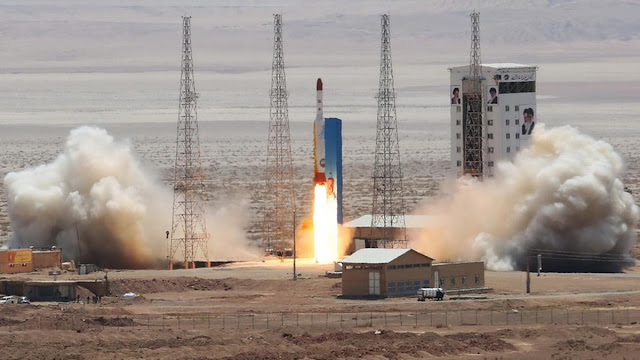Iran Prepares Next Satellite Launch
January 12, 2021January 12, 2021 (Gunnar Ulson - NEO) - The Iranian Space Agency (ISA) is preparing the launch of another satellite into orbit, the Zafar 2, which is described by Tehran Times as being capable of "taking color photos and [surveying] oil reserves, mines, forests, and natural lands."
Zafar 2 has been developed entirely within Iran by the Iranian University of Science and Industry.
Zafar 2's predecessor failed to reach orbit, but Iran has previously, successfully launched satellites to orbit including Omid in 2009, Rasad in 2011 and Navid in 2012.
Iran's current satellite launch vehicles consist of the Safir and Safir-2 rockets, the latter of which is also referred to as Simorgh.
These are considered as small-lift orbital launch vehicles or small launch vehicles (SLVs) comparable to Rocket Lab's Electron, Moscow Institute of Thermal Technology's Start-1, Orbital Sciences Corporation's Minotaur I, China's Long March 6 and Long March 11 as well as Japan Aerospace Exploration Agency's (JAXA) Epsilon and the European Space Agency's (ESA) Vega.
Why this is Important
Iran now belongs to an exclusive club of nations capable of building and launching vehicles and payloads into orbit. This small club includes Russia, the US, France, Japan, the UK, India, Israel, Ukraine, and North Korea. Many of these nations have previously developed the ability to send payloads into space but are not currently continuing to do so, meaning Iran belongs to a much more exclusive club still.
Iran has achieved this despite immense economic, political and military pressure from the US and its allies. This pressure manifests itself in the form of intense and enduring economic sanctions, political subversion and even covert and semi-covert military operations.
Iran's scientific community and military leadership are regularly targeted with assassinations and Iran's industrial infrastructure often suffers from "mysterious" accidents including fires and explosions.
And still Iran is capable of operating a functioning and active space program able to build both launch vehicles and practical satellites for further enhancing Iran's economic, military and scientific capabilities.
It is a reflection of a wider Iranian economy that has, because of US sanctions, become increasingly self-sufficient and resilient.
And while Iran's space program is sometimes dismissed as merely political posturing or accused of being cover for a clandestine weapons program capable of delivering nuclear warheads at wider ranges, there is an obvious economic benefit for cultivating a space program with capable small-lift orbital launch vehicles.
It is true that several other rockets in this category were developed from intercontinental ballistic missiles (ICBMs), but it is also true that these missiles were developed into commercial launch vehicles to exploit a growing market need for putting small satellites into orbit.
The orbital launch market is expanding in all dimensions, including small-lift orbital launch demand.
Market Watch in a report titled, "Small-lift Launch Vehicle Market : Global Industry brief Analysis by Top Countries Data, Market Size, Future Prospects And Outlook 2021-2024 with Remarkable Growth Rate," would note:
The small-lift launch vehicle market is expected to grow at a CAGR of 12% from 53.1 million USD in 2016 to reach 105.3 million USD by 2022 in Asia-Pacific market. The small-lift launch vehicle market is very concerted market; there are only top six players in Asia-Pacific.
With or without continued sanctions, a reliable small-lift orbital launch vehicle developed by Iran could not only allow Iran to build up its own orbital infrastructure aiding the Iranian economy in communications, navigation and imagery, but could also offer other nations without space programs launch services just as ESA, JAXA, Roscosmos and private operators like Rocket Lab do.
It is unlikely that this will happen any time soon, but developing such capabilities takes time and resources, and Iran is investing both toward what will be an eventual reality.
It is reasonable to assume that Iran's space program, as it gains experience and develops domestic rocket and satellite technology, will move into heavier payloads both within the small-lift orbital launch category and beyond. Again, this will further enhance Iran's economy, but also offer potential partners and customers a wider variety of launch services.
An Iran free of US sanctions, or at least an Iran in a multipolar world where US sanctions increasingly have little impact, is a nation that can convert its nascent space program into both a powerful means of enhancing its existing economic activity, as well as become a potential launch service to create new economic activity.
As we witness the US fade globally and its ability to impose itself on nations worldwide diminishes, the day where nations can freely deal with Iran may come sooner than later. Not only will this alleviate economic pressure on Iran and make available more resources to develop its domestic space program's capabilities, but it will allow the Iranian space program to benefit from technology from other nations as well.
Iran currently has several unfinished space-related projects and dormant partnerships with other nations both in Europe and across Eurasia, all put in stasis because of US pressure. Were Iran and its potential partners able to move around this pressure, these projects and partnerships, and much more, could move forward once again.
Iran is a nascent space-faring nation with the potential to join others in the near future, where the Iranian Space Agency is no longer merely demonstrating technology and launching basic payloads into orbit, but able to compete in and benefit commercially from emerging markets amid this new space race.
Gunnar Ulson, a New York-based geopolitical analyst and writer especially for the online magazine “New Eastern Outlook”.
References:
AMN News - Iran’s 2nd satellite is ready for launch despite US criticism:
https://www.almasdarnews.com/article/irans-2nd-satellite-is-ready-for-launch-despite-us-criticism/
Tehran Times - All-Iranian environmental satellite unveiled:
https://www.tehrantimes.com/news/444317/All-Iranian-environmental-satellite-unveiled
Market Watch - Small-lift Launch Vehicle Market : Global Industry brief Analysis by Top Countries Data, Market Size, Future Prospects And Outlook 2021-2024 with Remarkable Growth Rate:
https://www.marketwatch.com/press-release/small-lift-launch-vehicle-market-global-industry-brief-analysis-by-top-countries-data-market-size-future-prospects-and-outlook-2021-2024-with-remarkable-growth-rate-2020-12-25

